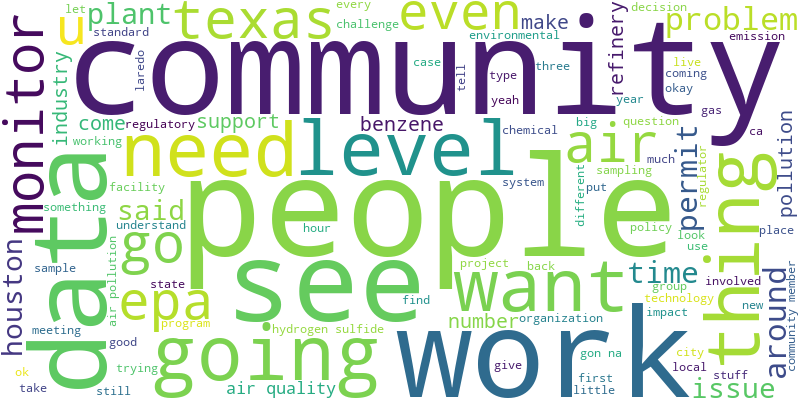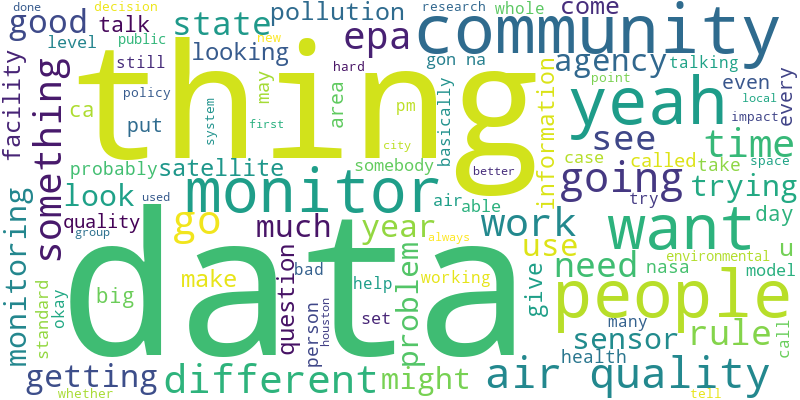NLP methodology development for analyzing communication patterns between institutional researchers and community scientists
Developed a comprehensive natural language processing methodology for analyzing stakeholder interview transcripts in environmental advocacy research. This proof-of-concept demonstrates how computational text analysis techniques can complement qualitative research methods and reveal communication patterns between different stakeholder groups.
The project showcases advanced NLP pipeline development, combining multiple analysis techniques to extract insights from interview data and establish a framework for larger-scale policy research studies.
Implemented for informal interview text with compound scoring
Topic modeling implementation for thematic analysis
Domain-specific stopword expansion and lemmatization
Word clouds and statistical summaries by stakeholder group
#!/usr/bin/env python3
# -*- coding: utf-8 -*-
"""
Environmental Advocacy Sentiment Analysis
Graduate Capstone Research Project
"""
import pandas as pd
import nltk
from nltk.corpus import stopwords
from nltk.tokenize import word_tokenize
from nltk.stem import WordNetLemmatizer
from vaderSentiment.vaderSentiment import SentimentIntensityAnalyzer
from sklearn.feature_extraction.text import CountVectorizer
from sklearn.decomposition import LatentDirichletAllocation
from wordcloud import WordCloud
import matplotlib.pyplot as plt
# Download NLTK resources
nltk.download('punkt')
nltk.download('stopwords')
nltk.download('wordnet')
# Load the data
df = pd.read_csv('/Users/courtneyj/Documents/Columbia/Fall 2024/NECR/Analysis/transcript.csv')
# Text preprocessing with additional stopwords
def preprocess_text(text):
# Default NLTK stopwords
stop_words = set(stopwords.words('english'))
# Add custom filler words to stopwords
custom_stopwords = {'actually', 'mean', 'think', 'like', 'right', 'kind', 'sort',
'got', 'maybe', 'really', 'say', 'way', 'lot', 'one', 'two'}
stop_words.update(custom_stopwords)
# Initialize lemmatizer
lemmatizer = WordNetLemmatizer()
# Tokenize and clean text
tokens = word_tokenize(text.lower())
tokens = [lemmatizer.lemmatize(word) for word in tokens
if word.isalpha() and word not in stop_words]
return ' '.join(tokens)
# Apply the updated preprocessing function
df['clean_text'] = df['text'].apply(preprocess_text)
# Sentiment Analysis
analyzer = SentimentIntensityAnalyzer()
def analyze_sentiment(text):
score = analyzer.polarity_scores(text)
return score['compound'] # Overall sentiment score
df['sentiment'] = df['clean_text'].apply(analyze_sentiment)
# Summarize sentiment by group
sentiment_summary = df.groupby('group')['sentiment'].describe()
print(sentiment_summary)
# Histogram for Community Science Group Only
plt.figure(figsize=(10, 6))
community_sentiment = df[df['group'] == 'Community']['sentiment']
plt.hist(community_sentiment, bins=10, alpha=0.7, color='blue', label='Community Science')
plt.title('Sentiment Distribution for Community Science Group')
plt.xlabel('Sentiment Score')
plt.ylabel('Frequency')
plt.legend()
plt.savefig('community_sentiment_histogram.png')
plt.show()
# Topic Modeling (LDA)
vectorizer = CountVectorizer(max_df=0.9, min_df=2, stop_words='english')
dtm = vectorizer.fit_transform(df['clean_text'])
lda = LatentDirichletAllocation(n_components=5, random_state=42)
lda.fit(dtm)
# Display top words per topic
def display_topics(model, feature_names, num_top_words):
for idx, topic in enumerate(model.components_):
print(f"Topic {idx+1}:")
print([feature_names[i] for i in topic.argsort()[-num_top_words:]])
display_topics(lda, vectorizer.get_feature_names_out(), 10)
# Word Cloud for Each Group
for group in df['group'].unique():
group_text = ' '.join(df[df['group'] == group]['clean_text'])
wordcloud = WordCloud(background_color='white', max_words=100, width=800, height=400)
wordcloud.generate(group_text)
plt.figure(figsize=(10, 6))
plt.imshow(wordcloud, interpolation='bilinear')
plt.axis('off')
plt.title(f"Word Cloud for {group.capitalize()} Group")
wordcloud.to_file(f'{group}_wordcloud.png')
plt.show()
# Export Results
df.to_csv('sentiment_analysis_results.csv', index=False)The VADER sentiment analyzer successfully processed interview transcripts, revealing distinct communication patterns between stakeholder groups. This proof-of-concept establishes the methodology for analyzing emotional tone in policy research interviews.
Pattern: Consistently measured tone
Approach: Technical, solution-oriented language
Professional communication style aligned with policy discourse norms
Pattern: Emotionally varied responses
Approach: Personal experience-driven language
Communication reflecting direct engagement with local environmental challenges
Implemented LDA topic modeling to demonstrate thematic analysis capabilities. The methodology successfully identified shared vocabulary and distinct focus areas between stakeholder groups, establishing a framework for larger-scale analysis.
Both groups emphasized data collection infrastructure
Different approaches to policy and permitting challenges
Shared focus on monitoring accuracy and reliability
Community focus on immediate, localized effects
Institutional emphasis on systematic approaches
Generated word clouds and statistical visualizations demonstrate the methodology's ability to reveal distinct language patterns between stakeholder groups.

Word frequency analysis reveals focus on community, people, permit, and pollution, indicating grassroots advocacy approaches and regulatory challenge navigation.

Language patterns emphasize data, project, state, and EPA, reflecting structured, policy-oriented approaches within governmental frameworks.
The NLP pipeline successfully identified communication pattern differences consistent with qualitative research expectations, demonstrating the methodology's potential for supporting policy research at scale.
This proof-of-concept establishes a reproducible methodology for analyzing stakeholder communication patterns in environmental policy research, ready for application to larger datasets.
Complete text processing workflow from raw interviews to analysis-ready data
Integration of sentiment analysis, topic modeling, and frequency analysis
Domain-specific stopword development and text cleaning optimization
VADER sentiment analysis and LDA topic modeling with scikit-learn
Computational analysis methodology development for policy research applications